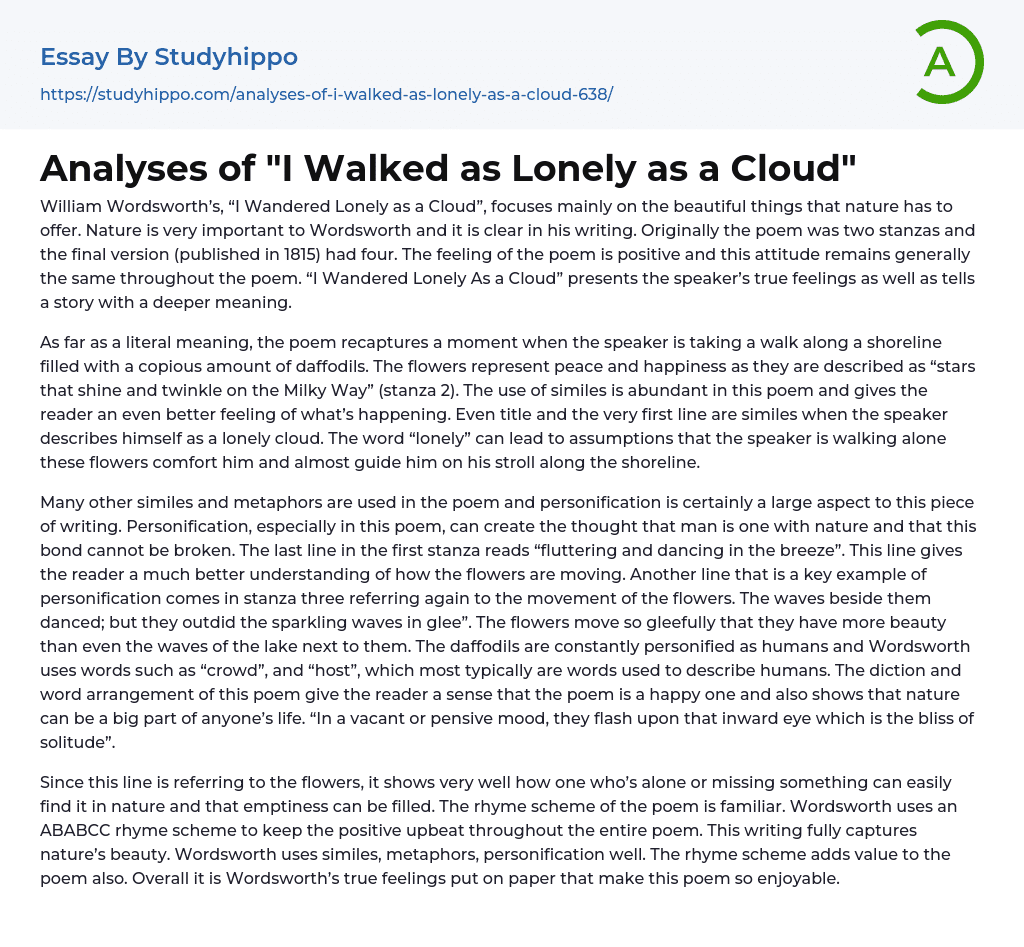

Analyses of “I Walked as Lonely as a Cloud” Essay Example
William Wordsworth's poem "I Wandered Lonely as a Cloud" centers on the allure of nature's beauty. Nature holds immense significance for Wordsworth, a theme that is evident throughout his work.
Originally, the poem had two stanzas but the final version (published in 1815) consisted of four stanzas. The overall tone of the poem is positive and this sentiment remains consistent throughout. "I Wandered Lonely As a Cloud" not only expresses the speaker's true emotions but also conveys a deeper message. In terms of the literal meaning, the poem recounts a moment when the speaker takes a walk along a shoreline that is abundant with daffodils. The flowers symbolize peace and happiness, described as "stars that shine and twinkle on the Milky Way" (stanza 2).
The poem is filled with numerous similes which enhance the reader's understanding. From the title and opening li
...ne, where the speaker compares himself to a lonely cloud, the use of similes creates a sense of companionship as the flowers comfort and guide him along the shoreline. Other similes and metaphors throughout the poem, along with personification, emphasize the connection between man and nature, illustrating an unbreakable bond. The first stanza concludes with the line "fluttering and dancing in the breeze".
This passage provides a clearer understanding of how the flowers are in motion, serving as a strong example of personification in stanza three. The reference to the flowers' movement states, "The waves beside them danced; but they outdid the sparkling waves in glee." It highlights how the flowers move with such joy that their beauty surpasses even the adjacent lake's waves. The daffodils are consistently personified as humans, with Wordsworth using terms like "crowd"
and "host" commonly used to describe people. The word choice and structure of this poem convey a sense of happiness and emphasize how nature can greatly impact one's life.
"In a vacant or pensive mood, the flowers flash upon that inward eye which is the bliss of solitude". This line effectively portrays how one who is alone or longing for something can find solace in nature and fill the void within. The poem maintains a familiar ABABCC rhyme scheme, ensuring a positive and uplifting tone throughout. Furthermore, Wordsworth skillfully employs similes, metaphors, and personification to vividly capture the beauty of nature in his writing.
The addition of the rhyme scheme also contributes value to the poem, but ultimately, it is Wordsworth's genuine emotions that truly make this poem enjoyable.
- 1984 essays
- A Farewell to Arms essays
- A Good Man Is Hard to Find essays
- A Hanging essays
- A Lesson Before Dying essays
- A Long Way Gone essays
- A Rose For Emily essays
- A Separate Peace essays
- A Tale Of Two Cities essays
- A Very Old Man With Enormous Wings essays
- Adventures Of Huckleberry Finn essays
- Alice in Wonderland essays
- All Quiet on The Western Front essays
- Allegory of the Cave essays
- An occurrence at owl creek bridge essays
- Animal Farm essays
- Anthem essays
- Antigone essays
- Arthur Conan Doyle essays
- As I Lay Dying essays
- Atticus Finch essays
- Barn Burning essays
- Battle Royal essays
- Beauty and The Beast essays
- Beloved essays
- Boo Radley essays
- Brave New World essays
- Candide essays
- Castle essays
- Characters In Hamlet essays
- Characters In Romeo And Juliet essays
- Christmas carol essays
- Chronicle of a Death Foretold essays
- Cinderella essays
- Crime and Punishment essays
- Daisy Miller essays
- Death of a Salesman American Dream essays
- Desdemona essays
- Diary Of A Wimpy Kid essays
- Dracula essays
- Dubliners essays
- Emma essays
- Ender'S Game essays
- Ethan Frome essays
- Eveline essays
- Fahrenheit 451 essays
- First-Person Narrative essays
- Fish Cheeks essays
- Frankenstein essays
- Genesis essays



